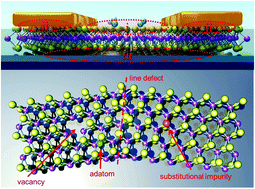当前位置:
X-MOL 学术
›
Chem. Soc. Rev.
›
论文详情
Our official English website, www.x-mol.net, welcomes your
feedback! (Note: you will need to create a separate account there.)
Two-dimensional transition metal dichalcogenides: interface and defect engineering
Chemical Society Reviews ( IF 40.4 ) Pub Date : 2018-03-06 00:00:00 , DOI: 10.1039/c8cs00024g Zehua Hu 1, 2, 3, 4, 5 , Zhangting Wu 6, 7, 8, 9 , Cheng Han 1, 2, 3, 4, 5 , Jun He 9, 10, 11, 12 , Zhenhua Ni 6, 7, 8, 9 , Wei Chen 1, 2, 3, 4, 5
Chemical Society Reviews ( IF 40.4 ) Pub Date : 2018-03-06 00:00:00 , DOI: 10.1039/c8cs00024g Zehua Hu 1, 2, 3, 4, 5 , Zhangting Wu 6, 7, 8, 9 , Cheng Han 1, 2, 3, 4, 5 , Jun He 9, 10, 11, 12 , Zhenhua Ni 6, 7, 8, 9 , Wei Chen 1, 2, 3, 4, 5
Affiliation

|
Two-dimensional (2D) transition metal dichalcogenides (TMDCs) have been considered as promising candidates for next generation nanoelectronics. Because of their atomically-thin structure and high surface to volume ratio, the interfaces involved in TMDC-based devices play a predominant role in determining the device performance, such as charge injection/collection at the metal/TMDC interface, and charge carrier trapping at the dielectric/TMDC interface. On the other hand, the crystalline structures of TMDCs are enriched by a variety of intrinsic defects, including vacancies, adatoms, grain boundaries, and substitutional impurities. Customized design and engineering of the interfaces and defects provides an effective way to modulate the properties of TMDCs and finally enhance the device performance. Herein, we summarize and highlight recent advances and state-of-the-art investigations on the interface and defect engineering of TMDCs and their corresponding applications in electronic and optoelectronic devices. Various interface engineering approaches for TMDCs are overviewed, including surface charge transfer doping, TMDC/metal contact engineering, and TMDC/dielectric interface engineering. Subsequently, different types of structural defects in TMDCs are introduced. Defect engineering strategies utilized to modulate the optical and electronic properties of TMDCs, as well as the developed high-performance and functional devices are summarized. Finally, we highlight the challenges and opportunities for interface and defect engineering in TMDC materials for electronics and optoelectronics.
中文翻译:

二维过渡金属二卤化物:界面和缺陷工程
二维(2D)过渡金属二硫化碳(TMDC)被认为是下一代纳米电子技术的有希望的候选者。由于其原子薄的结构和高的表面体积比,基于TMDC的器件所涉及的界面在确定器件性能方面起着主要作用,例如在金属/ TMDC界面处的电荷注入/收集以及在介电/ TMDC接口。另一方面,TMDC的晶体结构被各种内在缺陷所丰富,包括空位,原子,晶界和替代杂质。接口和缺陷的定制设计和工程设计提供了一种有效的方式,可以调节TMDC的属性并最终提高设备性能。在此处,我们总结并重点介绍了TMDC的接口和缺陷工程及其在电子和光电设备中的相应应用的最新进展和最新研究。概述了用于TMDC的各种接口工程方法,包括表面电荷转移掺杂,TMDC /金属接触工程和TMDC /电介质接口工程。随后,在TMDC中引入了不同类型的结构缺陷。总结了用于调制TMDC的光学和电子特性的缺陷工程策略,以及已开发的高性能和功能性设备。最后,我们重点介绍了用于电子和光电的TMDC材料中的界面和缺陷工程的挑战和机遇。
更新日期:2018-03-06
中文翻译:

二维过渡金属二卤化物:界面和缺陷工程
二维(2D)过渡金属二硫化碳(TMDC)被认为是下一代纳米电子技术的有希望的候选者。由于其原子薄的结构和高的表面体积比,基于TMDC的器件所涉及的界面在确定器件性能方面起着主要作用,例如在金属/ TMDC界面处的电荷注入/收集以及在介电/ TMDC接口。另一方面,TMDC的晶体结构被各种内在缺陷所丰富,包括空位,原子,晶界和替代杂质。接口和缺陷的定制设计和工程设计提供了一种有效的方式,可以调节TMDC的属性并最终提高设备性能。在此处,我们总结并重点介绍了TMDC的接口和缺陷工程及其在电子和光电设备中的相应应用的最新进展和最新研究。概述了用于TMDC的各种接口工程方法,包括表面电荷转移掺杂,TMDC /金属接触工程和TMDC /电介质接口工程。随后,在TMDC中引入了不同类型的结构缺陷。总结了用于调制TMDC的光学和电子特性的缺陷工程策略,以及已开发的高性能和功能性设备。最后,我们重点介绍了用于电子和光电的TMDC材料中的界面和缺陷工程的挑战和机遇。











































 京公网安备 11010802027423号
京公网安备 11010802027423号